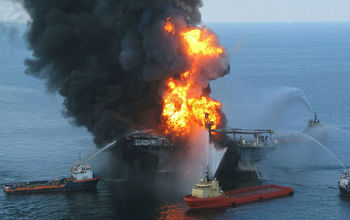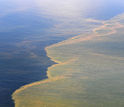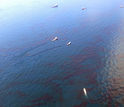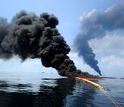Hola amigos: A VUELO DE UN QUINDE EL BLOG., hemos recibido información de la Fundación Nacional de Ciencia de Los Estados Unidos, quienes se hacen la pregunta: ¿Dónde está el petróleo de la Plataforma Deepwater Horizon? Para Davy Jones en el
fondo del mar...."La ubicación de los 2 millones de barriles de petróleo que se cree están atrapados en las profundidades del océano sigue siendo un misterio. Hasta ahora.......El científico David Valentine, de la Universidad de California en Santa Bárbara (UCSB) y sus colegas de la Institución Oceanográfica Woods Hole (WHOI) y la Universidad de California, Irvine, han descubierto el camino que el petróleo siguió a su lugar de descanso en el Golfo de México el mar piso.....Los hallazgos aparecen hoy en las Actas de revistas de la Academia Nacional de Ciencias......"Este análisis nos proporciona, por primera vez, un cierre en la pregunta, '¿Dónde está el petróleo y cómo llegó hasta allí?'", Dijo: Don Rice, Director la División de Océano del programa en la Fundación Nacional de Ciencia (NSF) Ciencias, que financió la investigación junto con la División de Ciencias de la Tierra de la NSF.............."Mediante el análisis de datos de más de 3.000 muestras recogidas en 534 localidades de más de 12 expediciones, los investigadores identificaron un parche 1.250 kilómetros cuadrados del fondo del mar en que se depositó cuatro a 31 por ciento del petróleo atrapado en las profundidades del océano. Eso es el equivalente de 2 a 16 por ciento del petróleo total descargada durante el accidente....... El petróleo sigue siendo en el Golfo de México más de cuatro años después del derrame de la plataforma Deepwater Horizon........."
New analysis traces oil to its resting place on the Gulf of Mexico sea floor
 Credit and Larger Version |
Where's the remaining oil from the 2010 Deepwater Horizon disaster in the Gulf of Mexico?
The location of 2 million barrels of oil thought to be trapped in the deep ocean has remained a mystery. Until now.
Scientist David Valentine of the University of California, Santa Barbara (UCSB) and colleagues from the Woods Hole Oceanographic Institution (WHOI) and the University of California, Irvine, have discovered the path the oil followed to its resting place on the Gulf of Mexico sea floor.
The findings appear today in the journal Proceedings of the National Academy of Sciences.
"This analysis provides us with, for the first time, some closure on the question, 'Where did the oil go and how did it get there?'" said Don Rice, program director in the National Science Foundation's (NSF) Division of Ocean Sciences, which funded the research along with NSF's Division of Earth Sciences.
"It also alerts us that this knowledge remains largely provisional until we can fully account for the remaining 70 percent."
For the study, the scientists used data from the Natural Resource Damage Assessment conducted by the National Oceanic and Atmospheric Administration.
The U.S. government estimates the Macondo Well's total discharge--from April until the well was capped in July--at 5 million barrels.
By analyzing data from more than 3,000 samples collected at 534 locations over 12 expeditions, the researchers identified a 1,250-square-mile patch of the sea floor on which four to 31 percent of the oil trapped in the deep ocean was deposited. That's the equivalent of 2 to 16 percent of the total oil discharged during the accident.
The fallout of oil created thin deposits that are most extensive to the southwest of the Macondo Well. The oil is concentrated in the top half-inch of the sea floor and is patchily distributed.
The investigation focused primarily on hopane, a nonreactive hydrocarbon that served as a proxy for the discharged oil.
The researchers analyzed the distribution of hopane in the northern Gulf of Mexico and found that it was concentrated in a thin layer at the sea floor within 25 miles of the ruptured well, clearly implicating Deepwater Horizon as the source.
"Based on the evidence, our findings suggest that these deposits are from Macondo oil that was first suspended in the deep ocean, then settled to the sea floor without ever reaching the ocean surface," said Valentine, a biogeochemist at UCSB.
"The pattern is like a shadow of the tiny oil droplets that were initially trapped at ocean depths around 3,500 feet and pushed around by the deep currents.
"Some combination of chemistry, biology and physics ultimately caused those droplets to rain down another 1,000 feet to rest on the sea floor."
Valentine and colleagues were able to identify hotspots of oil fallout in close proximity to damaged deep-sea corals.
According to the researchers, the data support the previously disputed finding that these corals were damaged by the Deepwater Horizon spill.
"The evidence is becoming clear that oily particles were raining down around these deep sea corals, which provides a compelling explanation for the injury they suffered," said Valentine.
"The pattern of contamination we observe is fully consistent with the Deepwater Horizon event but not with natural seeps--the suggested alternative."
While the study examined a specified area, the scientists argue that that the observed oil represents a minimum value. They believe that oil deposition likely occurred outside the study area but so far has largely evaded detection because of its patchiness.
"These findings," said Valentine, "should be useful for assessing the damage caused by the Deepwater Horizon spill, as well as planning future studies to further define the extent and nature of the contamination.
"Our work can also help assess the fate of reactive hydrocarbons, test models of oil's behavior in the ocean, and plan for future spills."
Co-authors of the paper are G. Burch Fisher and Sarah C. Bagby of UCSB; Robert K. Nelson, Christopher M. Reddy and Sean P. Sylva of WHOI and Mary A. Woo of University of California, Irvine.
-NSF-
Julie Cohen, UCSB, (805) 893-7220, julie.cohen@ucsb.edu
Related WebsitesNSF News: Study Identifies Source of Oil Sheens Near Deepwater Horizon Site: http://www.nsf.gov/news/news_summ.jsp?cntn_id=128494
NSF News: Gulf Oil Spill: NSF Awards Rapid Response Grant to Study Microbes' Natural Degradation of Oil: http://www.nsf.gov/news/news_summ.jsp?cntn_id=116993
NSF News: Gulf of Mexico Topography Played Key Role in Bacterial Consumption of Deepwater Horizon Spill: http://www.nsf.gov/news/news_summ.jsp?cntn_id=122736
NSF News: Chemical Make-up of Gulf of Mexico Plume Determined: http://www.nsf.gov/news/news_summ.jsp?cntn_id=120962
NSF News: Research Mission Studies Oil Spill Using Autonomous Underwater Vehicle and Mass Spectrometry: http://www.nsf.gov/news/news_summ.jsp?cntn_id=117200
NSF Grant: Collaborative Research: Oxygenation of Hydrocarbons in the Ocean: http://www.nsf.gov/awardsearch/showAward?AWD_ID=1333162&HistoricalAwards=false
is an independent federal agency that supports fundamental research and education across all fields of science and engineering. In fiscal year (FY) 2014, its budget is $7.2 billion. NSF funds reach all 50 states through grants to nearly 2,000 colleges, universities and other institutions. Each year, NSF receives about 50,000 competitive requests for funding, and makes about 11,500 new funding awards. NSF also awards about $593 million in professional and service contracts yearly.
Useful NSF Web Sites:
NSF Home Page:
http://www.nsf.gov
NSF News:
http://www.nsf.gov/news/
For the News Media:
http://www.nsf.gov/news/newsroom.jsp
Science and Engineering Statistics:
http://www.nsf.gov/statistics/
Awards Searches:
http://www.nsf.gov/awardsearch/

Map of the Northern Gulf of Mexico with sampling sites in the study. Hotter colors equal more oil.
Credit and Larger Version

The Deepwater Horizon oil is likely at the bottom of the Gulf of Mexico.
Credit and Larger Version

Hydrocarbons from the Deepwater Horizon spill overlaid on sea floor bathymetry of the study area.
Credit and Larger Version

Two million barrels of oil are submerged on the sea-floor of the Gulf.
Credit and Larger Version

Dark clouds of smoke emerge as a controlled burn of spilled oil takes place on the surface.
Credit and Larger Versión
NASA
Guillermo Gonzalo Sánchez Achutegui
ayabaca@gmail.com
ayabaca@hotmail.com
ayabaca@yahoo.com
Inscríbete en el Foro del blog y participa : A Vuelo De Un Quinde - El Foro!

No hay comentarios:
Publicar un comentario